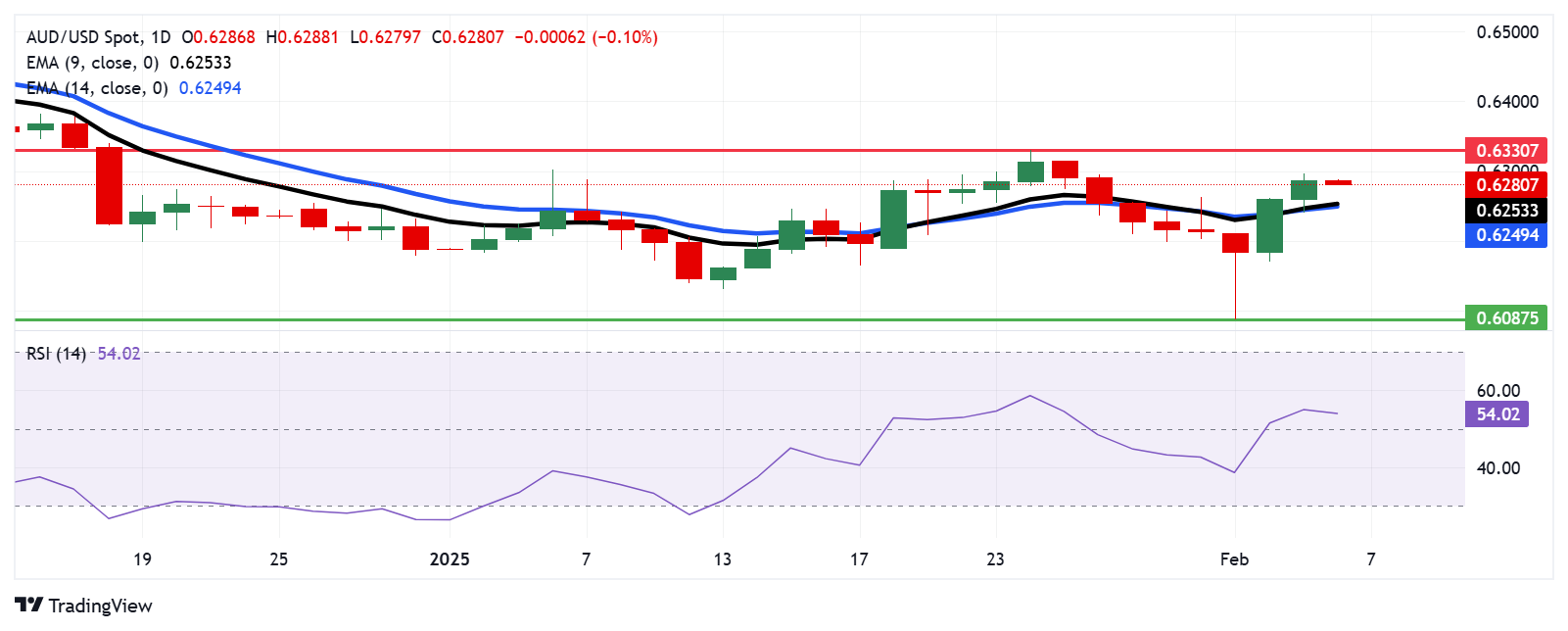- The Australian Dollar holds losses after the release of lower-than-expected Trade Balance data.
- Australia’s trade surplus dropped to 5,085M in December, below the expected 7,000M and down from the 6,792M prior.
- The US Dollar faced challenges as the ISM Services PMI eased in January.
The Australian Dollar (AUD) edges lower against the US Dollar (USD) following lower-than-expected Trade Balance data released on Thursday. Additionally, the AUD/USD pair receives downward pressure from risk-off sentiment amid rising fears over US-China trade tensions.
Australia’s trade surplus fell to 5,085M in December, missing the expected 7,000M and down from the previous surplus of 6,792M. Exports increased by 1.1% MoM, slowing from November’s 4.2% rise, while imports surged 5.9% MoM, up from 1.4% in the prior month.
Traders closely watch the ongoing trade war between the United States (US) and China, Australia’s key trading partner. China retaliated against the new 10% US tariff that took effect on Tuesday. However, Trump stated on Monday afternoon that he would likely speak with China within the next 24 hours. He also warned, “If we can’t reach a deal with China, the tariffs will be very, very substantial.”
Australian Dollar receives downward pressure from rising US-China trade tensions
- The US Dollar Index (DXY), which measures the US Dollar’s value against six major currencies, remains under subdued near 107.50 at the time of writing. The weaker US Services Purchasing Manager Index (PMI) could have weighed on the Greenback.
- The US ISM Services PMI eased to 52.8 in January from 54.0 (revised from 54.1) in December. This reading came in below the market consensus of 54.3.
- Traders brace for Friday’s US Nonfarm Payrolls (NFP) data, which is expected to shape the Federal Reserve’s (Fed) monetary policy direction.
- President Trump has agreed to a 30-day suspension of the proposed 25% tariffs on Canadian and Mexican imports. This decision comes after Canadian Prime Minister Justin Trudeau and Mexican President Claudia Sheinbaum committed to enhancing border security measures to address concerns over illegal immigration and drug trafficking.
- China’s Commerce Ministry announced that it will impose a 15% tariff on US coal and liquefied natural gas (LNG) imports, along with an additional 10% tariff on crude Oil, farm equipment, and certain automobiles. Additionally, to “safeguard national security interests,” China is implementing export controls on tungsten, tellurium, ruthenium, molybdenum, and related products.
- According to the Financial Times, Chinese exporters are intensifying their efforts to offshore production in response to Trump’s tariffs. Manufacturers in China are accelerating plans to relocate production to other countries, including the Middle East, to avoid US tariffs. Other tactics being considered include passing the increased costs onto US consumers and exploring alternative markets.
- JOLTS Job Openings fell to 7.6 million in December, missing the 8 million consensus estimate. The US labor market remains stable with total separations little changed at 5.3 million in December.
- San Francisco Fed Bank President Mary Daly stated on Tuesday that the central bank remains in a wait-and-see stance, emphasizing the impact of economic uncertainty on policymaking. While the economy is performing well and maintaining momentum, uncertainty persists. As a result, the Fed has the flexibility to carefully assess data before making policy adjustments.
- Australia’s Judo Bank Composite PMI climbed to 51.1 in January from 50.2 in December, reflecting modest growth in private sector activity. Meanwhile, the Judo Bank Services PMI rose to 51.2 from 50.8, marking the twelfth consecutive month of expansion in the services sector. Although growth was moderate, it was the strongest since August.
Australian Dollar pulls back from 0.6300, support appears at nine-day EMA
The AUD/USD pair trades near 0.6280 on Thursday. Sustained price action above the nine- and 14-day Exponential Moving Averages (EMAs) on the daily chart indicates a stronger short-term bullish momentum. Additionally, the 14-day Relative Strength Index (RSI) is positioned above the 50 level, confirming a stronger bullish trend.
On the upside, the AUD/USD pair could explore the area around its seven-week high at 0.6330 level, which was recorded on January 24.
The AUD/USD pair may find immediate support at the nine-day EMA near 0.6254, followed by the 14-day EMA at 0.6249 level. A break below these EMAs could weaken the bullish bias, potentially driving the pair toward 0.6087, the lowest level since April 2020, which was recorded on February 3.
AUD/USD: Daily Chart

Australian Dollar PRICE Today
The table below shows the percentage change of Australian Dollar (AUD) against listed major currencies today. Australian Dollar was the weakest against the Japanese Yen.
| USD | EUR | GBP | JPY | CAD | AUD | NZD | CHF | |
|---|---|---|---|---|---|---|---|---|
| USD | 0.07% | -0.01% | -0.23% | 0.05% | 0.10% | 0.05% | 0.03% | |
| EUR | -0.07% | -0.08% | -0.30% | -0.01% | 0.03% | -0.01% | -0.06% | |
| GBP | 0.01% | 0.08% | -0.25% | 0.07% | 0.11% | 0.07% | 0.04% | |
| JPY | 0.23% | 0.30% | 0.25% | 0.30% | 0.34% | 0.26% | 0.27% | |
| CAD | -0.05% | 0.00% | -0.07% | -0.30% | 0.05% | -0.00% | -0.02% | |
| AUD | -0.10% | -0.03% | -0.11% | -0.34% | -0.05% | -0.04% | -0.09% | |
| NZD | -0.05% | 0.01% | -0.07% | -0.26% | 0.00% | 0.04% | -0.02% | |
| CHF | -0.03% | 0.06% | -0.04% | -0.27% | 0.02% | 0.09% | 0.02% |
The heat map shows percentage changes of major currencies against each other. The base currency is picked from the left column, while the quote currency is picked from the top row. For example, if you pick the Australian Dollar from the left column and move along the horizontal line to the US Dollar, the percentage change displayed in the box will represent AUD (base)/USD (quote).
Australian Dollar FAQs
One of the most significant factors for the Australian Dollar (AUD) is the level of interest rates set by the Reserve Bank of Australia (RBA). Because Australia is a resource-rich country another key driver is the price of its biggest export, Iron Ore. The health of the Chinese economy, its largest trading partner, is a factor, as well as inflation in Australia, its growth rate and Trade Balance. Market sentiment – whether investors are taking on more risky assets (risk-on) or seeking safe-havens (risk-off) – is also a factor, with risk-on positive for AUD.
The Reserve Bank of Australia (RBA) influences the Australian Dollar (AUD) by setting the level of interest rates that Australian banks can lend to each other. This influences the level of interest rates in the economy as a whole. The main goal of the RBA is to maintain a stable inflation rate of 2-3% by adjusting interest rates up or down. Relatively high interest rates compared to other major central banks support the AUD, and the opposite for relatively low. The RBA can also use quantitative easing and tightening to influence credit conditions, with the former AUD-negative and the latter AUD-positive.
China is Australia’s largest trading partner so the health of the Chinese economy is a major influence on the value of the Australian Dollar (AUD). When the Chinese economy is doing well it purchases more raw materials, goods and services from Australia, lifting demand for the AUD, and pushing up its value. The opposite is the case when the Chinese economy is not growing as fast as expected. Positive or negative surprises in Chinese growth data, therefore, often have a direct impact on the Australian Dollar and its pairs.
Iron Ore is Australia’s largest export, accounting for $118 billion a year according to data from 2021, with China as its primary destination. The price of Iron Ore, therefore, can be a driver of the Australian Dollar. Generally, if the price of Iron Ore rises, AUD also goes up, as aggregate demand for the currency increases. The opposite is the case if the price of Iron Ore falls. Higher Iron Ore prices also tend to result in a greater likelihood of a positive Trade Balance for Australia, which is also positive of the AUD.
The Trade Balance, which is the difference between what a country earns from its exports versus what it pays for its imports, is another factor that can influence the value of the Australian Dollar. If Australia produces highly sought after exports, then its currency will gain in value purely from the surplus demand created from foreign buyers seeking to purchase its exports versus what it spends to purchase imports. Therefore, a positive net Trade Balance strengthens the AUD, with the opposite effect if the Trade Balance is negative.
























